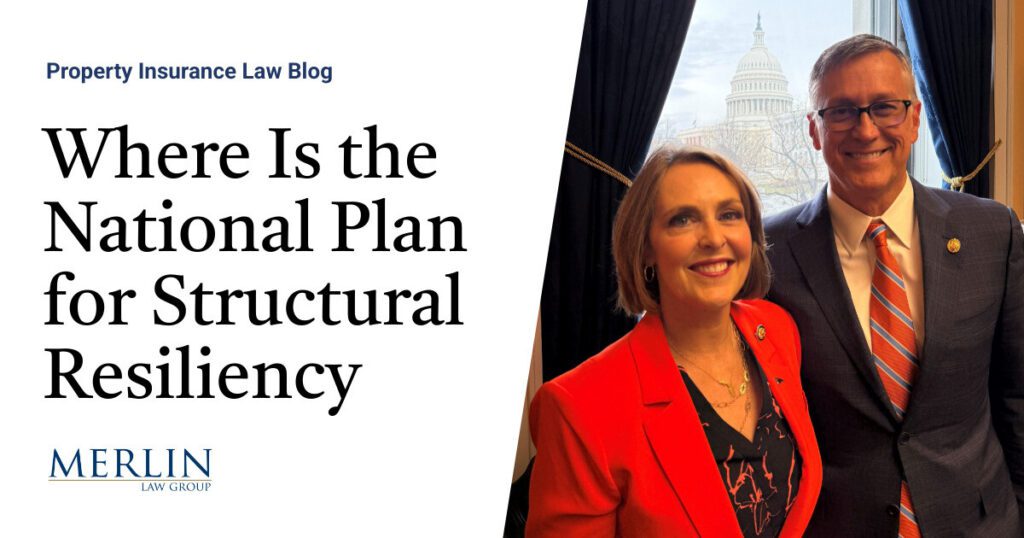Where Is the National Plan for Structural Resiliency? If there is to Be Available and Affordable Insurance, Then Property Has to Be More Resilient to Damage

What is the comprehensive plan for structural resilience to natural disasters? Resilience extends beyond individual buildings and cities; it requires a regional and national approach to infrastructure development. Coordinated efforts between federal, state, and local governments create cohesive policies that address large-scale vulnerabilities. Stakeholders within the insurance industry have rightfully been calling for more leadership to address these issues. Last week, I heard Fred Karlinksy at the Windstorm Insurance Conference discuss how Florida has been addressing these concerns and his call for more to be done. The actions of leaders and some states taking action on these issues are commendable but too few.
Bill Lewis is a partner and General Counsel at the insurance defense firm Butler, Weihmuller, Katz & Craig. His wife is Kathy Castor. She has been a United States Congressional Representative since 2006. Castor chaired the Select Committee on the Climate Crisis. The final staff report from that committee, Solving the Climate Crisis 2022: Key Accomplishments and Additional Opportunities, 1 had a section reserved for resilience to natural disasters caused by climate change and stated the following, in part:
Despite massive public investments to shore up the nation’s infrastructure and help communities prepare for and recover from disasters, the United States lacks a comprehensive plan to address the nation’s need to adapt and build resilience to climate impacts. The federal government lacks a unified strategy to coordinate across multiple departments, agencies, and programs to develop actionable climate risk information and provide urgently needed technical and financial assistance.
The insurance industry has been warning about the financial risks of climate change for decades. Major insurance companies, reinsurers, and industry groups have been raising concerns about the increasing frequency and severity of natural disasters, attributing them to climate change, since at least the 1970s and 1980s. In 1973, Munich Re, a leading reinsurance company, published a brochure on flooding that is believed to be one of the earliest instances where the term “climate change” was used in the context of insurance risks. 2 Munich Re advertises its work warning about the impact of climate change causing greater natural disasters and cites to Munich Re establishing its Geo Risks Research Department to analyze the impact of global warming on natural disasters in 1988. 3
In 2006, Lloyd’s of London released a report titled “Adapt or Bust,” emphasizing the necessity for the insurance industry to prepare for the increasing volatility of the climate. That 2006 report noted, in part:
We foresee an increasing possibility of attributing weather losses to man made factors, with courts seeking to assign liability and compensation for claims of damage. Exposures can also be expected to increase in respect of property, business interruption and political risks, demanding the same response. That means the insurance industry will want to regularly review conditions of coverage against risk appetite, and do more to educate the public about changing exposures. The industry can help by creating incentives for policyholders to reduce risk…
Based on long experience, Lloyd’s believes that insurance markets operate most efficiently when left to free market forces, and the vast majority of natural perils are insurable – as long as the market is free to price risk adequately. However, if this freedom is removed, or if the pace of climate change grows faster than expected, this could change our view. Industry strategists will want to consider the long-term insurability of weather-related risk. We believe that a meaningful partnership with government and business, supported by a series of practical actions, has the best chance of providing solutions. In particular, this should address the issue of increasing concentrations of population and economic wealth in high risk areas, for example on coasts. This report focuses on adaptation but we recognise that mitigation of the risk itself (ie the reduction of CO2 emissions) is crucial.
Lloyd’s is not some “tree hugger” environmentalist in the caricatured sense that some like to mock, but it does recognize the financial risks of climate change and the need for sustainable insurance practices. Lloyd’s are experts at property insurance risk management. They were warning leaders and businesses nearly 20 years ago that climate change was real, carbon emissions needed to be cut, and resilience was needed. Some paid attention, but many mocked the need for change or acted to preserve the status quo agenda of various self-interest groups.
The world’s largest reinsurer, Swiss Re, published an article in November 2023, We Need to Talk About Climate Adaptation. The article warned that “climate change poses the biggest long-term risk to the global economy. No action is not an option.” It stated in part:
Investing in adaptation will increase resilience by supporting economic stability, create job opportunities and protect the environment, but the inability to easily quantify and compare the financial benefits has contributed towards a significant gap in adaptation financing.” Yet, as our analysis shows, the benefits of the right adaptation measures can outweigh costs by a factor of 10 or more in the face of natural disasters.
The National Association of Insurance Commissioners (NAIC) has consistently emphasized the importance of building resilience against natural disasters, particularly in the context of climate change. Recognizing the increasing frequency and severity of natural catastrophes, the NAIC has implemented several initiatives to promote the construction of structures capable of withstanding such events.
In March 2024, the NAIC adopted its first National Climate Resilience Strategy for Insurance. This strategy aims to drive faster and more effective risk reduction by state insurance regulators, ensuring that insurance remains available and reliable for communities facing climate risks. Key components of the strategy include advocating for home hardening against wildfires, floods, and storms, utilizing catastrophe modeling information, and better informing the public of risks. Interestingly, the report references a California wildfire program, Safer From Wildfires, and references regulations California adopted in 2022. 4
The NAIC has established a Climate and Resiliency Task Force to coordinate discussions and engagement on climate-related risk and resiliency issues. This task force focuses on various workstreams, including climate risk disclosure and pre-disaster mitigation, to enhance the resilience of communities and the insurance market.
The point is that I testified two weeks ago in Tallahassee that resiliency to damage is the one long-term solution to insurance availability and affordability. Everybody recognizes it, but not enough are making it a priority. I wrote in The Community Necessity to Make Structures More Insurable and Resilient to Loss:
The point of this post is that property insurance should always be considered a social product. Property insurance for structures has historically required communities to make the insured structures insurable. In the 19th century, as cities grew and fires became a significant risk to urban areas, city governments and communities implemented several measures to ensure that insurance companies found them insurable for writing fire insurance. These measures aimed to reduce fire risk and improve firefighting capabilities, thereby making urban properties more attractive to insurers.
…
The insurance product is no longer limited to fire insurance as it was in the 19th century. Commissioner Yaworsky’s comments and views reflect that Florida’s insurance community may have to take significant steps to reduce the risk of loss from windstorms and hurricanes. This will be fought by those selling asphalt roofs and homeowners having to replace those lower-priced components of a home. But his question raises the question: What are we willing to do as a community to take action to make our structures more resilient and more insurable? There is no free lunch when it comes to the cost of property ownership. If one cannot afford the insurance, can one really afford the cost of the structure in the first place? What can we do to lower the long-term and overall cost of real property ownership?
In Panel Discussion on Homeowner’s Property Insurance Cost Drivers, I argued that “I agree with the insurance industry that we have a societal obligation to help reduce the frequency and severity of loss. This is not a new concept but one that has been understood for well over two hundred years when it comes to the affordability of homeowners insurance…” The one thing Congress, the largest insurance companies in the world, the NAIC, Fred Karlinksy, and Chip Merlin all agree upon is that we need to make our property more resilient to loss if we want an affordable and available insurance product.
I will educate and voice this concern to those in a position to do something about this. I suggest others do so as well before it is too late. Truthfully, maybe it already is, but we have to keep trying.
Thought For The Day
“We are close to the tipping point where global warming becomes irreversible. Climate change is one of the great dangers we face.”
—Stephen Hawking
1 Solving the Climate Crisis 2022: Key Accomplishments and Additional Opportunities, Majority Staff Report, 117th Congress (Dec. 2022).
2 Marcus Baram, How Big Insurance’s Investment in Fossil Fuels Came Back to Bite It, Capital & Main, Jan. 22, 2025.
3 Weather extremes, climate change and net-zero: Perspectives from Munich Re (June 2024).
4 Cal. Code Regs. Tit. 10, § 2644.9.



